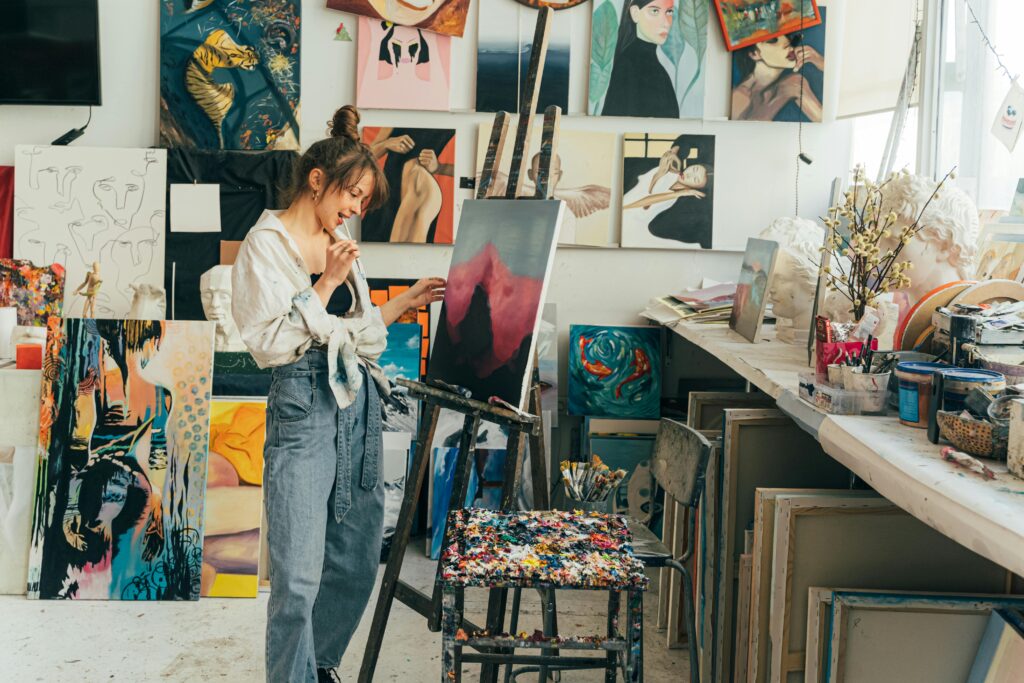Visual art is almost entirely unrepresented at Eastern. In fact, visual art is underrepresented and undervalued in American culture in general. Many individuals, on the other hand, favor visual art over or alongside other forms of art (music, theatre, etc.). However, such individuals at Eastern University have no way of pursuing this interest academically.
It is easy to say that of course art lovers deserve to develop this form of creativity as much as a theatre or music lover, but can we make a practical argument in favor of visual art? I can certainly make a personal argument in favor of art. While most children in the U.S. take music lessons of some kind as a matter of course, I was enrolled in painting lessons and pottery classes. In the same way that piano lessons might teach you to listen well, these art classes taught me to see well. Studying visual art teaches you to see the world through a more intentional and creative lens.
But I am not the only one who thinks that. In her book Visual Intelligence, Amy Herman talks about the importance of being able “to see more and to observe more accurately.” Herman runs a program called the Art of Perception, which trains people from a variety of professions – including the FBI, the Navy, and the Department of Justice – to observe more closely so they do not miss important details. And she teaches this art of seeing through literal visual art – often just by looking at the great works of art! Looking carefully at paintings teaches people to focus on details they might otherwise miss, eventually training their eyes to be detail oriented. Similarly, according to the National Library of Medicine, studies show that learning art could strengthen your brain in various unexpected ways. For example, studying visual art can be complementary to studying science in that it improves your perception and cognition. Art can also help a person learn to self reflect, express themselves, be persistent, and go outside of their comfort zone. Even the United Nations Educational, Scientific, and Cultural Organization recognizes “the essential role of art in the life and development of the individual and of society.” Art, including visual art, affects the shifts in trends, morals, and worldview of our society. Art can be a tool to fight oppression. Studying art can put you in a position to interact with our changing society through your art.
The only class at Eastern that I know of that resembles a visual art class is Dr. Cox’s Beauty and the Arts class in the Honors college. The course explores through both a philosophical and creative lens the questions: What is beauty and art? And why do we create? Although the approach is mostly what one might call theoretical, Dr. Cox still emphasizes the experiential. Students watch movies and go on field trips in order to interact with art and beauty on a sensory level. The class culminates with a creative. When I took the course last semester, the creative projects ranged from carved icons to tattoo art to lyre music. While the course does not exclusively focus on visual art, it incorporates art history and even drawing classes in class time. This class is just a taste of the variety of classes a major in visual art could include.
But if you cannot justify adding a major purely for the sake of creativity and beauty, then consider that art is actually surprisingly professionally practical. An art major can set you up to be a tattoo artist, a graphic designer, a fashion designer, a cosmetologist, an art teacher, a photographer, or an illustrator. You could pair an art minor with a math major and then a higher degree in engineering or architecture, in order to create more beautiful buildings and structures. Or, you could combine an art minor with a major in computer science and design beautiful websites, or else with a major in psychology and go into art therapy.
Ok, but what does an art major or minor even look like? Probably an art major or minor at Eastern would look pretty interdisciplinary, especially at first. Perhaps, like Dr. Cox’s Beauty and the Arts class, the major would include classes on the philosophy of beauty. We could work with the history department for art history classes or with the communications department for classes on graphic design. Then, of course, the major would include the actual art classes, beginning with foundational drawing skills, and progressing to various forms of painting and art styles. To sufficiently teach seeing and creating, we don’t need any fancy materials.
The addition of an art minor or major on campus would open up a whole new creative path in Eastern’s curriculum, and could be achieved with minimum disruption. What are we waiting for?
Herman, Amy, Visual Intelligence. New York: Mariner Books. Print.

